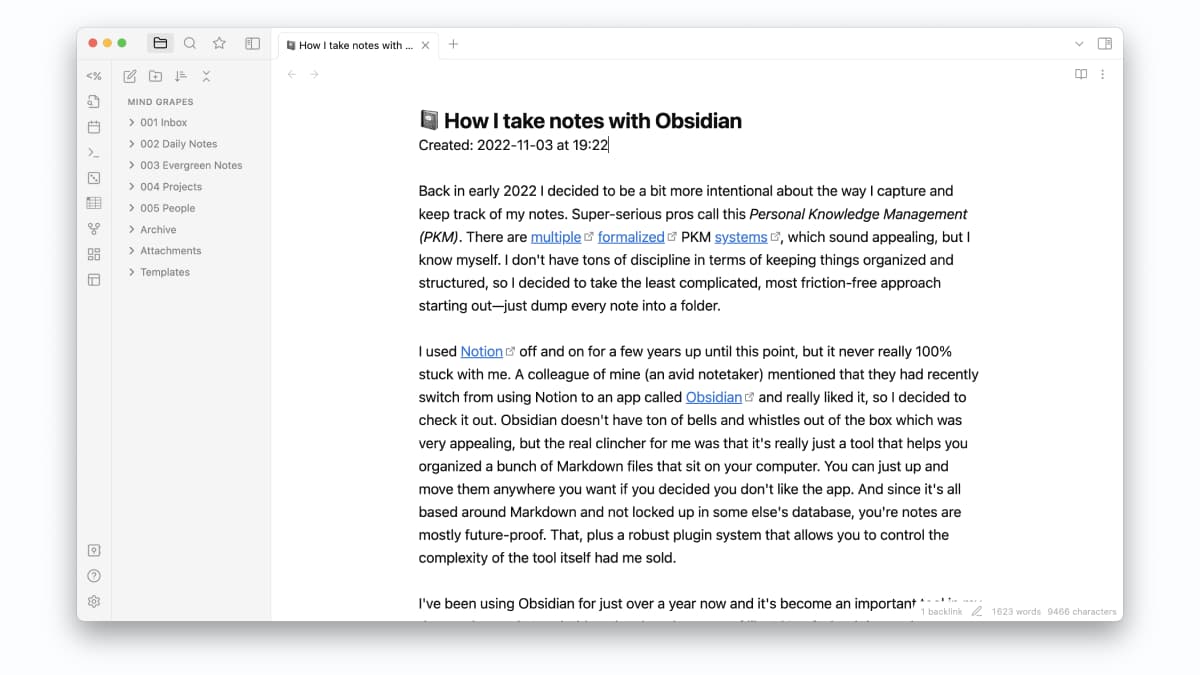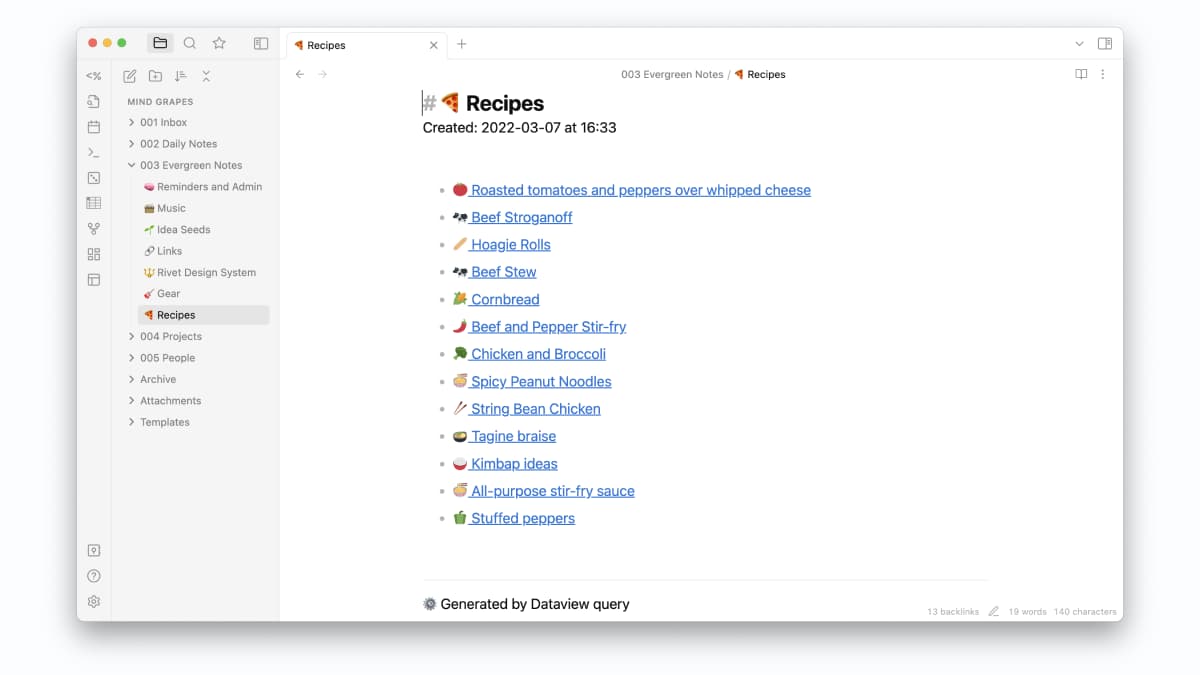How I take notes with Obsidian
Back in early 2022 I decided to start being a bit more intentional about the way I capture and keep track of my notes. Super-serious pros call this Personal Knowledge Management (PKM). There are multiple formalized PKM systems, which sound appealing, but I know myself. I don't have tons of discipline in terms of keeping things organized and structured, so I took the least complicated, most friction-free approach to get started—just dump every note into a folder.
I used Notion off and on for a few years up until that point, but it never really stuck for me. A colleague of mine (an avid notetaker) mentioned that they had recently switch from using Notion to an app called Obsidian. They had nothing but good things to say, so I decided to check it out.
Obsidian doesn't have ton of bells and whistles out of the box which was very appealing, but the real clincher for me was that it's really just a tool that helps you organized a bunch of Markdown files that sit on your computer. You can up and move them anywhere you want if you decided you don't like the app. And since it's all based around Markdown (plain text files) and not locked up in some else's database, your notes are mostly future-proof. That plus a robust plugin system that allows you to control the complexity and feature set of the app had me sold.
I've used Obsidian for just over a year now and it's become an important tool in my day-to-day work. I probably only take advantage of about 10% of what it is possible to do with the app, but I thought I would share my personal set up, including some of the plugins and features I can't live without.
A quick note. This isn't meant to be a tutorial on how to use Obsidian, for that you should definitely check out this Nicole van der Hoeven's YouTube channel. They have tons of great videos about all aspects of taking notes with Obsidian.
My set up
I've taken inspiration from some of the more formal systems mentioned above, but I try to keep my system as simple as possible and only introduce complexity when it actually helps me be more productive and/or stay more organized. I mostly rely on search to navigate my vault, as Obsidian calls it, so the structure is pretty flat. Here's what my vault set up looks like.

Daily Notes
Daily notes is a core plugin that gives you an easy way to create a daily note from a template. There is an additional plugin called Calendar that works really well with daily notes. It gives you a nice calendar view in the right sidebar that makes it easy open notes from a specific day of the month.
As I already mentioned, I don't put a ton of structure around my daily notes. They tend to serve as an all-purpose scratchpad most days. I draft emails there, capture interesting links, and other random things I want to remember.
Inbox
This is the engine room of my vault. I defined my Inbox folder as the default location for all new notes so I don't have to stop and think about where to put notes and can get straight to caputring whatever I'm working on. The important thing here is that there's no friction to creating a new note.
There are no subfolders inside my Inbox. Instead I use backlinks to other notes (more on that later) to organize things. This folder is just a catch-all spot for new notes. Obsidian has a great find functionality (⌘ + O) that I use to navigate between notes, so additional folder structure in my Inbox isn't that important.
I try to spend some time each week organizing my Inbox notes. Mostly that means adding backlinks where needed to what I call index notes, which are a loose interpretation of the Maps of Content (MOCs) concept. In general, I make heavy use of backlinks to organize notes, but a lot of people also use tags or even folders to keep things organized. I haven't found a way that tags add value to my workflow, but I can see why a lot of folks make heavy use of them.

I use the Dataview plugin to auto-generate a list of linked notes in my index notes (similar to a MOC). All I have to do is add a backlink in any note to its parent index note and the dataview plugin will automatically display a link to that new note.
Evergreen notes
This is where I keep most of my Index notes. The content of this folder changes over time based on long-running projects I'm working on, hobbies that I'm into at the moment, etc. But, some things like Idea Seeds and Recipes are permanent.
Projects
These notes are similar to evergreen notes, but have a finite lifespan. They are projects that have a beginning and end. They generally start off as a single note or outline and eventually become index notes that use the Dataview plugin to create an index out of backlinks. Once I'm finished with a project note, it gets moved into the Archive folder.
There is a really cool new-ish plugin called Projects that I started using recently and it's pretty great. It brings a lot of the functionality of Notion databases to Obsidian which can be really very for larger projects with lots of tasks and research associated with it.
People
This is a new (to me) folder I've been experimenting with recently, but people notes is a fairly common practice in the PKM world, especially for folks that do a lot of more formal research. I'm sort of thinking of it like my own lightweight CRM. My people notes work very similar to evergreen notes and projects. Each note is an index note for a person with an auto-generated list of links to other notes related to them. I use these to keep track of notes from 1:1s at work, important details from doctors visits, and contact info for service providers like plumbers, HVAC repair, etc.
Archive
The Archive folder is where notes go when I'm done with them, but I'm bad about staying on top of this. For example, there are tons of notes in my inbox that I would probably only rarely need to reference, if ever. I should probably be more diligent about moving those to my archive, but there's always room for improvement 🤷♂️.
Attachments & Templates
These two are pretty boring, but worth mentioning. The Attachements folder is where any media like images and videos get automatically stored when you paste or drag them into a note. My Templates folder is where is store templates for different types of notes that I create often. For example, my daily note. 🔥 Hot tip 🔥 there is a great plugin called Templater that does some cool dynamic stuff with note templates. Definitely worth checking out.
Wrapping up
To wrap up here are some of my favorite plugins, themes, and features.
- Graph view — As I mentioned, I use a lot of backlinks to organize notes. The graph view is a neat way to visualize all of the connections between your notes.
- Dataview plugin — I've talked about this a lot already, but it's a must-have in my opinion
- Calendar — Really helpful if you're taking daily notes
- Emoji Toolbar — 🤓 Makes it easy to insert emoji using the command palette (⌘ + P)
- Minimal theme — this is by far the most popular theme and the best looking, IMO
I'm far from being an Obsidian power user, but this system works for me. If you're looking to be more intentional in your daily note-taking practice, the best advice I have is keep things as simple and only layer on complexity and/or organization when it actually makes your life easier.